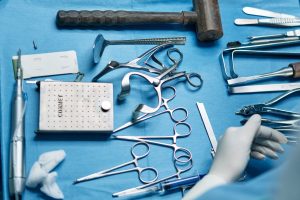In metal fabrication, a crucial aspect includes in the capacity not only to shape and mold metal components but also to perform precise metal cutting to meet the specific requirements of a project. Precision metal cutting techniques play a vital role in the processing of raw materials, serving as essential high-quality components across diverse industries. Utilizing metal materials or tools is prevalent within the manufacturing sector, thereby underscoring the significance of metal-cutting processes in driving its operations, both directly and indirectly.
Metal-cutting processes encompass many applications, each tailored to meet specific requirements within various industries. As a result, an array of distinct precision metal-cutting techniques has emerged to cater to these diverse needs. In this article, you will learn the various metal fabrication methods available, offering insights into their applications and aiding in the selection of the most suitable metalworking technique to fulfill specific requirements.
Precision Metal Cutting Techniques
Precision metal cutting techniques are fundamental in numerous industries where precision and efficiency are critical. Among the most prominent methods are laser cutting, waterjet cutting, plasma cutting, and wire EDM (Electrical Discharge Machining).
Laser Cutting
Laser cutting utilizes a focused laser beam to cut through metal with extremely precise. This high-precision machining process involves directing the laser beam onto the metal surface, causing it to melt, burn, or vaporize along the cutting path. Laser cutting is ideal for intricate designs and thin materials due to its minimal heat-affected zone and narrow kerf width. It offers high repeatability and can cut through various metals, including steel, aluminum, and stainless steel.
Waterjet Cutting
Waterjet cutting employs a high-pressure stream of water mixed with abrasive particles to cut through metal. This versatile metal fabrication method can cut various materials, including metals, ceramics, and composites, without heat-affected zones or material distortion. Waterjet cutting is particularly suitable for materials sensitive to heat, such as aluminum and Titanium. It enables the cutting of thick metals with ease and provides excellent precision, making it preferred for intricate shapes and detailed designs.
Plasma Cutting
Plasma cutting uses a high-velocity jet of ionized gas (plasma) to melt and remove metal from the workpiece. Effective for cutting electrically conductive materials like steel, stainless steel, and aluminum, plasma cutting offers high speeds and can handle a wide range of thicknesses. While it may produce a wider kerf compared to laser cutting, plasma cutting is cost-effective and efficient for industrial applications.
EDM (Electrical Discharge Machining) Cutting
CNC EDM cutting is a high-precision machining method that uses electrical discharges for material removal processes from a workpiece. A thin, electrically conductive wire is guided along a programmed path, creating sparks that erode the material into the desired shape. Wire EDM is highly accurate and capable of producing intricate geometries with tight tolerances. It excels with hard metals and complex shapes that conventional machining struggles with. Additionally, wire EDM minimizes distortion and stress on the workpiece, as it applies no mechanical force.
Factors Affecting Precision Metal Cutting
Precision metal cutting is indispensable in industries such as aerospace, automotive, and manufacturing, where the production of high-quality components relies heavily on advanced cutting tools. Achieving precise cuts requires considering factors including:
Material Type
The material type plays a crucial role in precision metal-cutting techniques. Metals vary in properties, such as hardness, ductility, and thermal conductivity, which directly influence the cutting process. For instance, while softer metals like aluminum may be more easily cut, harder materials such as stainless steel or titanium require a specialized machining process and tools.
Moreover, exotic materials like Inconel or titanium alloys present unique challenges due to their strength and heat resistance, necessitating advanced cutting tools and techniques.

The Thickness of The Material
The thickness of the material is another critical factor affecting precision metal cutting. Thicker materials require higher cutting forces and may demand more robust tools and CNC machining to achieve accurate cuts. Additionally, thicker materials can generate more heat during cutting, potentially leading to issues like thermal distortion or hardening. The choice of the cutting method, whether it’s laser cutting, waterjet cutting, or traditional machining processes like milling or turning, is also influenced by the thickness of the material.
Tolerance and Accuracy Requirement
Precision metal cutting is often performed to meet specific tolerance and accuracy requirements dictated by the final application of the components. Tight tolerances and high accuracy demand call for precise cutting techniques and advanced equipment. Factors such as tool deflection, machine stability, and cutting speed must be carefully controlled to achieve the desired precision levels.
Additionally, considerations such as burr formation, surface roughness, and dimensional accuracy become crucial when aiming for stringent tolerance levels. Advanced machining technologies like CNC machining and laser-guided cutting systems are commonly employed to meet these demands.
Here’s a table summarizing the factors affecting precision metal cutting:
| Factor | Description |
| Material Properties | Hardness, toughness, and flexibility of the metal being cut. |
| Tool Material | Type of cutting tool used, such as carbide or high-speed steel. |
| Cutting Speed: | The speed at which the tool moves relative to the workpiece. |
| Machine Rigidity | Stability and stiffness of the cutting machine. |
| Tool Geometry: | Shape and angles of the cutting tool’s edges. |
| Environmental Conditions | Temperature, humidity, and cleanliness of the cutting environment. |
Application of Precision Metal Cutting
Precision metal-cutting techniques are indispensable across diverse industries, including aerospace, automotive, and medical device manufacturing. Here are how these techniques are harnessed within each sector:
Aerospace Industry
In the aerospace sector, precision metal cutting techniques serve as the backbone for crafting critical components with exacting standards for quality and performance. These techniques facilitate the production of intricate parts utilized in aircraft, spacecraft, and propulsion systems.
Applications
- Aircraft Structures: Precision metal cutting is instrumental in fabricating aircraft structures like fuselage panels, wing components, and engine mounts. CNC machining processes ensure meticulous shaping and drilling of aerospace-grade materials such as aluminum alloys and titanium.
- Engine Components: Precision machining techniques are employed to craft engine components like turbine blades, compressor rotors, and fuel system parts. High-precision machining guarantees the dimensional accuracy and surface finish essential for optimal engine performance.
- Aerospace Fasteners: Precision metal cutting is vital in manufacturing aerospace fasteners, encompassing bolts, nuts, and screws. Using CNC machining processes enables the production of high-strength fasteners with precise threading and tight tolerances.
Automotive Industry
Precision metal cutting techniques are vital for generating high-quality components that underpin vehicle safety, performance, and reliability.
Applications
- Engine Components: Precision metal cutting is leveraged to manufacture engine components like cylinder heads, pistons, and crankshafts. Employing CNC machining processes facilitates the production of components with precise geometries and tight tolerances, which are crucial for efficient engine operation.
- Transmission Parts: Precision metal cutting techniques are utilized in crafting transmission components such as gears, shafts, and clutch plates. Utilization of advanced cutting tools and CNC machining ensures the accuracy and durability of transmission parts.
- Chassis and Suspension: Precision metal cutting finds application in producing chassis and suspension components, including frame rails, control arms, and steering knuckles. CNC machining processes fabricates lightweight yet robust components, enhancing vehicle handling and stability.
Medical Devices Manufacturing
In medical device manufacturing, precision metal cutting techniques are crucial for fabricating intricate and high-precision components used in medical equipment and implants.
Applications
- Surgical Instruments: Precision metal cutting is employed in manufacturing surgical instruments like scalpels, forceps, and scissors. Using CNC machining processes ensures the precise shaping and sharpening of instrument blades, meeting stringent medical standards.
- Implantable Devices: Precision metal cutting techniques play a crucial role in fabricating implantable medical devices such as orthopedic implants, pacemaker components, and dental prosthetics. Leveraging advanced cutting tools and CNC machining enables the production of biocompatible implants with precise dimensions and surface finishes.
- Diagnostic Equipment: Precision metal cutting is utilized in producing diagnostic equipment components like X-ray housings, MRI coils, and ultrasound transducers. CNC machining processes ensure the fabrication of components with tight tolerances and intricate geometries necessary for accurate medical imaging.
Challenges and Solutions in Precision Metal Cutting
Precision metal cutting encounters challenges that can affect the production of high-quality components. Here are three significant challenges faced in precision metal cutting and the solutions to address them effectively.
Heat-Affected Zone
Challenge
During precision metal cutting processes like laser cutting or plasma cutting, intense heat is generated, leading to the formation of a heat-affected zone (HAZ) around the cut edges. The HAZ can result in changes to the material’s microstructure, altering its mechanical properties and potentially causing dimensional inaccuracies or structural weaknesses.
Solutions
- Controlled Cooling: Implementing controlled cooling mechanisms, such as using coolant jets or compressed air, helps dissipate heat quickly from the cutting zone, thereby reducing the extent of the HAZ.
- Optimized Cutting Parameters: Adjusting cutting parameters – cutting speed, power intensity, and beam focus – helps control heat generation. Adjustments to these parameters help minimize the size and depth of the HAZ.

- Post-Cutting Heat Treatment: Performing post-cutting heat treatments like annealing or stress relieving helps mitigate the effects of the HAZ by restoring the material’s properties and relieving residual stresses induced during cutting.
Material Distortion
Challenge
Mechanical forces exerted during precision metal cutting can induce material distortion, particularly in thin or delicate materials. Material distortion can lead to dimensional inaccuracies, warping of the workpiece, and compromised part quality.
Solutions
- Stabilized Fixturing: Ensuring proper fixturing and clamping of the workpiece is essential to stabilize it during cutting. Well-designed fixtures minimize movement and vibration, reducing potential material distortion.
- Reduced Cutting Forces: Implementing strategies to reduce cutting forces, such as using sharper cutting tools or optimizing cutting parameters, helps mitigate material distortion. Optimizing like feed rate and depth of cut can minimize stress on the workpiece.
- Preventive Measures: Taking preventive measures like preheating the material or using pre-straightened stock helps minimize inherent stresses in the material. This reduces the likelihood of material distortion during cutting and ensures dimensional accuracy in the finished parts.
Burr Formation
Challenge
Burr formation, characterized by the creation of raised edges along the cut surface, is a common issue in precision metal cutting. Burrs can adversely affect surface finish, interfere with assembly processes, and pose safety hazards.
Solutions
- Sharp Cutting Tools: The use of sharp cutting tools with appropriate geometries is crucial in minimizing burr formation. Sharp tools ensure clean and precise cuts, reducing the occurrence of burrs along the cut edges.
- Optimized Cutting Parameters: Fine-tuning cutting parameters such as feed rate, cutting speed, and tool geometry play a vital role in controlling burr formation. Adjustments to these parameters help achieve optimal cutting conditions and minimize burrs.
- Post-Cutting Deburring: Implementing post-cutting deburring processes, such as grinding, sanding, or chemical deburring, effectively removes burrs and ensures a smooth surface finish. Automated deburring equipment can streamline the deburring process, improving efficiency and consistency.
Best Practices for Precision Metal Cutting
Incorporating best practices can significantly enhance the efficiency and accuracy of the cutting process. Here are two essential aspects:
Advanced CAD/CAM Software Utilization
Utilizing advanced Computer-Aided Design (CAD) and Computer-Aided Manufacturing (CAM) software plays a pivotal role in optimizing precision metal-cutting processes.
1. Design Optimization
CAD Modeling: Commence with comprehensive CAD modeling of the desired part or component, ensuring precise dimensions and geometric accuracy.
Design for Manufacturability: Design parts with manufacturability in mind, considering factors such as material properties, machining capabilities, and tooling constraints.
Virtual Prototyping: Utilize CAD software to simulate the cutting process virtually, allowing for optimization of toolpaths and cutting strategies before physical machining begins.
2. CAM Programming
Toolpath Optimization: CAM software enables the generation of optimized tool paths, minimizing unnecessary tool travel and reducing machining time.
Parameter Optimization: Fine-tune cutting parameters such as feed rates, spindle speeds, and tool engagement to maximize efficiency while maintaining quality.
Integration with Machine Tools: Seamless integration between CAM software and CNC machining tools ensures accurate execution of programmed toolpaths, minimizing errors and maximizing productivity.
3. Continuous Improvement
Feedback Loop: Establish a feedback loop between CAD/CAM design and machining processes to identify areas for improvement and implement iterative enhancements.
Training and Skill Development: Provide training and ongoing education to operators and engineers to maximize proficiency in utilizing advanced CAD/CAM software capabilities effectively.
Quality Control Measures
Quality control measures are indispensable to ensure that precision metal-cutting processes consistently meet the required standards and specifications.
Pre-Production Inspection
- Material Inspection: Thoroughly inspect raw materials for defects, inconsistencies, or impurities that could affect machining quality.
- Tool Inspection: Verify the condition and sharpness of cutting tools before machining to prevent tool wear or breakage during cutting.
- Machine Calibration: Regularly calibrate CNC machining tools to maintain accuracy and repeatability in machining operations.
In-Process Monitoring
- Real-Time Monitoring: Implement real-time monitoring systems to track key machining parameters such as cutting forces, temperatures, and tool wear during the cutting process.

- Dimensional Checks: Conduct periodic dimensional checks using precision measurement tools to ensure that machined parts meet specified tolerances and dimensions.
Post-Production Inspection
- Surface Finish Evaluation: Inspect the surface finish of machined parts using visual inspection or surface profilometers to ensure adherence to quality standards.
- Defect Identification: Conduct thorough inspections to identify any defects, burrs, or irregularities that may affect part functionality or appearance.
- Quality Documentation: Maintain comprehensive documentation of quality control procedures, inspection results, and any corrective actions taken to ensure traceability and accountability.
Conclusion
Metal cutting in precision engineering has undergone significant transformations over time. With the rising demands for high-quality metal parts and mass metal components, manufacturers and service providers are increasingly relying on high-tech metal cutting tools to fulfill their promises.
If you’re seeking metal cutting techniques like laser cutting, waterjet cutting, or shearing services for your project, rest assured that Zintilon is here to support you every step of the way. Our expertise enables us to cut a diverse range of metals into precise shapes, sizes, and quantities, precisely meeting your exact specifications. Contact us to discuss your cutting requirements with one of our experts.
FAQs about Metal Cutting Techniques
What are some common precision metal cutting techniques?
Common precision metal cutting techniques include laser cutting, waterjet cutting, plasma cutting, and wire EDM (Electrical Discharge Machining). Each technique offers unique advantages and is chosen based on the specific requirements of the project.
How do manufacturers ensure high-quality components through precision metal cutting?
Manufacturers ensure high-quality components through precise control of cutting parameters, such as cutting speed, feed rate, and tooling selection. Additionally, rigorous quality control measures, including inspection and testing, are implemented throughout the cutting process.
How does computer-aided manufacturing (CAM) software contribute to precision metal cutting?
CAM software plays a crucial role in precision metal cutting as it enables precise programming of cutting paths and parameters, optimizing toolpaths which helps to minimize material waste and enhance efficiency.
What are some common challenges faced in precision metal cutting, and how are they addressed?
Common challenges include heat-affected zones, material distortion, and burr formation. These challenges are addressed through controlled cooling methods, stabilized fixturing, and post-cutting deburring processes, among other techniques.




